
The project uses a FPGA kit and sensors to collect soil pH, soil moisture, soil temperature and soil NPK in smart farm to improve agriculture data collection and analysis
Demo Video
Project Proposal
1. High-level project introduction and performance expectation
The raised rate always more growing of demography in Cameroun causes a significant increase in food demand. The farmers are obliged to exploit their soil relatively with short time intervals. However, the ground needs a certain time to recover its content of organic nutriments. A short fallow of the soil causes a modification of the ecosystem, biodiversity and unsustainable agriculture. The direct consequence is the very bad productivity of the soil by a bad quality and quantity of the culture thus stirring the reduction in the selling prices, the increase in the production costs and the abandonment of the activity.
Usually, the identification of a fertile soil for a field is done in an analog way by ancestral methods. For example, the presence of the soil worms and snail, the presence of the vegetable species such as Andropogon Tectorum would indicate the fertility of the grounds [1]. In addition, even the texture of the soil would give the same indications [2]. However, these methods do not reveal the organic nutriments quantity in the soil which gives its fertility. However, for a sustainable and rentable agriculture, the knowledge of the exact quantities of the organic nutriments such as Nitrogen (N), Phosphorus (P) and Potassium (K) want to be very essential because it will make it possible to take good decision for a sustainable agriculture.
Indeed, the Nitrogen (N) is very essential for the growth and maturity of the plants [1], Phosphorus (P) is very essential in the enlargement and maturity of the plants [1] and Potassium (K) is very essential for the enlargement, the growth and the quality of the plants [1]. However, these minerals are essential only in certain proportions established by standards [1]. In addition, their good values are for certain values of the pH, the temperature and the moisture of the soil. Thus to control the pH of the ground, the temperature of the soil and its moisture also makes it possible to control the nutritive elements of the ground.
In this project we develop a smart farm system carried out around a DE-10 NANO FPGA, able (a) to measure and scope in real time the pH, the temperature and the moisture of the soil as well as the content of Nitrogen (N), Phosphorus (P) and Potassium (K) of the ground; (b) to send in real time these information via Bluetooth to the famers; and (c) to take decisions on the measures which not respecting the standard by sending alarm message via system GSM to the famers. The Bluetooth network and GSM are selected for reasons of limited Internet network cover in the countries in development process such as Cameroon. In addition, the use of the FPGA is because of its advantages on other numerical processors.
Indeed, a FPGA has the advantage of very high speeds parallel processing, to be flexible by its reprogramming at will and especially to be closer to the real time by the hardware implementation of its algorithms. These advantages make it possible to adapt our system on any type of agricultural soil and for any type of agriculture, for example the agriculture of manioc, plantain-banana, cacao, rice, cotton and well others. And even if we limit ourselves to the Bluetooth and GSM networks, our application can extend on Wi-Fi and Internet.
References:
- C. S. A. Ballot, G. MAwUSSI, w. Atakpama, M. moita-nassy, T. M. yangakola, I. Zinga, Silla S, Kpérkouma w, G. Dercon, Komlan B et Koffi A, 2016. ‘‘Caractérisation physico-chimique des sols en vue de l’amélioration de la productivité du manioc (manihot esculenta Crantz) dans la région de damara au centre-sud de centrafrique’’. Agronomie Africaine, vol 28 (1), pp 9 – 23.
- Chambre d’agriculture de la Drôme, novembre 2013. ‘’ Analyser son sol pour mieux le connaître’’. N°64.
2. Block Diagram
The block diagram of the system suggested is given on figure 1.
Figure 1. Block Diagram of proposed system
In this block diagram, the moisture and temperature of the soil are delivered by the S-Soil MT-02A sensor, while NPK Soil sensor delivers the values of NPK. The various values delivered by the sensors are acquired by ADC LTC2308 available on the DE10-Nano kit. The FPGA can reach the ADC by ADC series controller thus giving access of the NIOS II. The implemented algorithms make it possible to recover the acquired values, to in addition send these values by Bluetooth through the HC-05 module. If an acquired value does not respect the standard, simultaneously the red lamp alarm of monitoring representing the value is lit and an alarm message is sent to the famers via SeedStudio GSM module. The famer is informed in real time and can thus take good decisions to optimize his production and to preserve the ecosystem and his biodiversity.
3. Expected sustainability results, projected resource savings
The expected value of a good pH of the soil allowing a good development of the organic nutriments lies between 6,5 and 7,5 [2]. While the soil moisture must be at least to 50% and the temperatures ranging between 7°C and 35°C. In addition [1] gives in the form of table, the standardized values of Nitrogen (N), Phosphorus (P) and potassium (K). As follows:
- The good values of the Nitrogen (N) lie between 1,2 and 2,2 g/Kg;
- The good values of Phosphorus (P) lie between 0,20 and 0,23 g/Kg;
- The good Potassium (K) values are higher than 3,7 g/Kg.
The standardized values given higher are those which our system must control. As soon as it has variation with the standard, the system reacts intelligently by sending an alarm message to the famer to correct it. For example, figure 2 below presents the simulation of pH channel with hardware implementation in Matlab/Simulink R2020a with DsPBuilder Tools. It is seen well that the alarm red lamp remains extinct when the value of the pH is good (figure 2a), but it ignites rather when the pH is out of the standard (figure 2b). The output "pH-abnormal_output " is that which activates GSM module for message sending. the hardware implementation of the other channels follows same logic.
|
|
Figure 2. Simulation dans Matlab de la voie d’acquisition du pH par DsPBuilder :
- Bonne valeur du pH; b) mauvaise valeur du pH
The system instantiated around the NIOS II in Plattform Designer is given on the figure 3 below in which outputs "led_alarm" will make it possible to light the alarm lamps via relays for out-standards measurements. The output "uart_Bluetooth" will be connected to the Bluetooth module and the output "uart_gsm" with GSM module. The software system making it possible the NIOS II to access to the resources will be programmed in "NIOS II Software Build for Eclipse ".
Figure 3. Smart Farm NIOS II system instantiated
The first compilation in Quartus II of the resources used by our system is given on figure 4. We can see the lowest resources utilization.
Figure 4. Ressources saving
References:
- C. S. A. Ballot, G. MAwUSSI, w. Atakpama, M. moita-nassy, T. M. yangakola, I. Zinga, Silla S, Kpérkouma w, G. Dercon, Komlan B et Koffi A, 2016. ‘‘Caractérisation physico-chimique des sols en vue de l’amélioration de la productivité du manioc (manihot esculenta Crantz) dans la région de damara au centre-sud de centrafrique’’. Agronomie Africaine, vol 28 (1), pp 9 – 23.
- Chambre d’agriculture de la Drôme, novembre 2013. ‘’ Analyser son sol pour mieux le connaître’’. N°64.
4. Design Introduction
The raised rate always more growing of demography in Cameroun causes a significant increase in food demand. The farmers are obliged to exploit their soil relatively with short time intervals. However, the soil needs a certain time to recover its content of organic nutriments. A short fallow of the ground causes a modification of the ecosystem, biodiversity and unsustainable agriculture. The direct consequence is the very bad productivity of the ground by a bad quality and quantity of the culture thus stirring the reduction in the selling prices, the increase in the production costs and the abandonment of the activity.
In this project we work on the sustainable agriculture by using the intelligent system to preserve the biodiversity. In short we use the IoT as the Bluetooth and Wi-Fi Network to connect an agricultural farm to a smartphone to better control soil parameters such as: the pH, moisture and NPK nutrients. The Bluetooth module makes it possible to collect the data in real Time on the farm while the Wi-Fi module implemented in MQTT protocol makes it possible to collect them anywhere. For that, we defined two applications for monitoring on Bluetooth and Wi-Fi in which the farmers can follow the evolution of the Soil parameters to take better decisions in order to improve quality and quantity of their farms while preserving the biodiversity.
The intelligent system carried out around a DE-10 NANO FPGA, is able (a) to measure in real time the pH and the moisture of the soil as well as the content of Nitrogen (N), Phosphorus (P) and Potassium (K) of the ground; (b) to send in real time these information via Bluetooth and Wi-Fi to the smartphone of famers; and (c) to take automatically decisions on the moisture measures which are below 50% according the standard by starting the motor-pump for soil irrigation. To improve our system, the GSM referred above was replaced by Wi-Fi for more flexibility because this one gives more access to the system thanks to connection Internet constantly and in anywhere.
FPGA Virtues in Our Project
The use of the FPGA is because of its advantages on other numerical processors. In our system, the virtues brought by the FPGA are:
- very high speeds parallel processing: The data comes from many sensors and are sent to many network simultaneously. So we need all the treatment in parallel. The FPGA takes the step on the others because it parallel treatment at great frequencies.
- Flexibility: FPGA is very large flexible by its reprogramming and reconfigurability at will. It is possible to expand the project by adding functionalities to each stage of the development without being obliged to start again. These advantages make it possible to adapt our system on any type of IoT, any type of agricultural soil and for any type of agriculture such as the agriculture of manioc, plantain-banana, cacao, rice, cotton and well of other. In addition, The co-design of SoPC is reconfigurable at will and allows for this purpose a design and a rapid test of our system.
- The real time process: The hardware implementation of its algorithms under VHDL makes that their operation approaches the real time because this one reduces the delay of treatment whose systems sequential have
Significant sustainability goals of the project
- Capability of the project of making a real-world impact to our use of the world's resources.
We point out that we make an acquisition of the soil parameters of an agriculture farm such as The pH and moisture. Thus the knowledge of these parameters makes it possible to make decisions on the soil resources to be exploited in particular and those of the world in general. For example, an acid or basic soil reveals a rather poor quantity of NPK nutriment which are not soluble in these soils and thus no exploitable. And of this fact the use of these resources will not have any effect, only to degrade yet more the soil. On the other hand, the soil moisture makes it possible to know at which time to irrigate it. However an irrigation without control can cause an acidification of the soil, and thus a bad pH.
Thus the soil pH and moisture that we acquire in our project thus will impact the use of the world’s resources because they will allow:
- Not to exploit a soil with bad pH in order to let it renew fear of making it toxic because a toxic soil has serious consequences in health;
- To avoid deforestation for the use of the resource wood for fear the soil releases greenhouse gas in the Atmosphere which will amongst other things cause climate change in all the world with all its consequences;
- To know the quality of the resource water in a zone in order to avoid any toxicity on health.
Taking into consideration of what precedes, we can affirm that our project, which works on a sustainable agriculture impacts enormously on the use of the others world’s resources.
- The project reduces meaningfully environmental impact and help people live better lives.
The project developed and proposed reduced indeed the environmental impact and makes it possible to the people to better live. Indeed, the sustainable development passes by the control of the soil because it is the essential element. The acquired parameters make it possible to avoid a bad exploitation of the soil because it causes an impoverishment of the soil. A soil degraded impact entirely on:
- Biodiversity and ecosystem;
- The climate change with the emission greenhouse gas in the atmosphere because the soil is not able any more to filter them;
- The quality of collected food influencing the health of the people;
- The cycle of water
As we said, if the soil pH is not neutral, then one would be brought to avoid his farm and in this case one could not have food toxicity and the soil will have all its time to be renewed. A soil which was well renewed entirely plays its fundamental functions which are: food, filtering, biology, material and of support. one sees there clearly how the knowledge of the pH of an agricultural soil reduced the environmental impact and allows the people to better live.
- The papers that work in the sustainable agiculture
Ramya Venkatesan and Anandhi Tamilvanan [3] proposes a system of soil temperature and moisture acquisition through a raspberry pi with a system of irrigation. The Wi-Fi network is used to transfer the data collected to the server In which Web page is created for monitoring. However, this work is limited by the Raspberry pi card which it uses which is not reconfigurable. Thereafter the authors added another ADC, ADC PCF8591, for the analog to digital conversion of the data. What still makes the hardware system voluminous. Moreover this ADC does not allow any extension because it comprises 4 analog inputs, a maximum acquisition of four parameters. All this shows the advantage of using a FPGA and especially DE10 nano. In addition the acquired data are not plotting in the form of curve. That makes it not possible to follow the evolution of the parameters acquired and then to make any prevision.
Another paper which makes in agriculture is that of D.Murali et al. [4] in which they use also a chart Raspberry-pi to acquire the moisture of the ground with the smartphone connected via protocol MQTT. the system of irrigation is controlled via GSM. There too, limits of the chart used makes that it y' has acquisition of only one parameter. From where the advantage of using a FPGA.
5. Functional description and implementation
The Functional diagram of the suggested system is given on figure 5. To improve our system, we replace GSM module by Wi-fi ESP8266 Module.
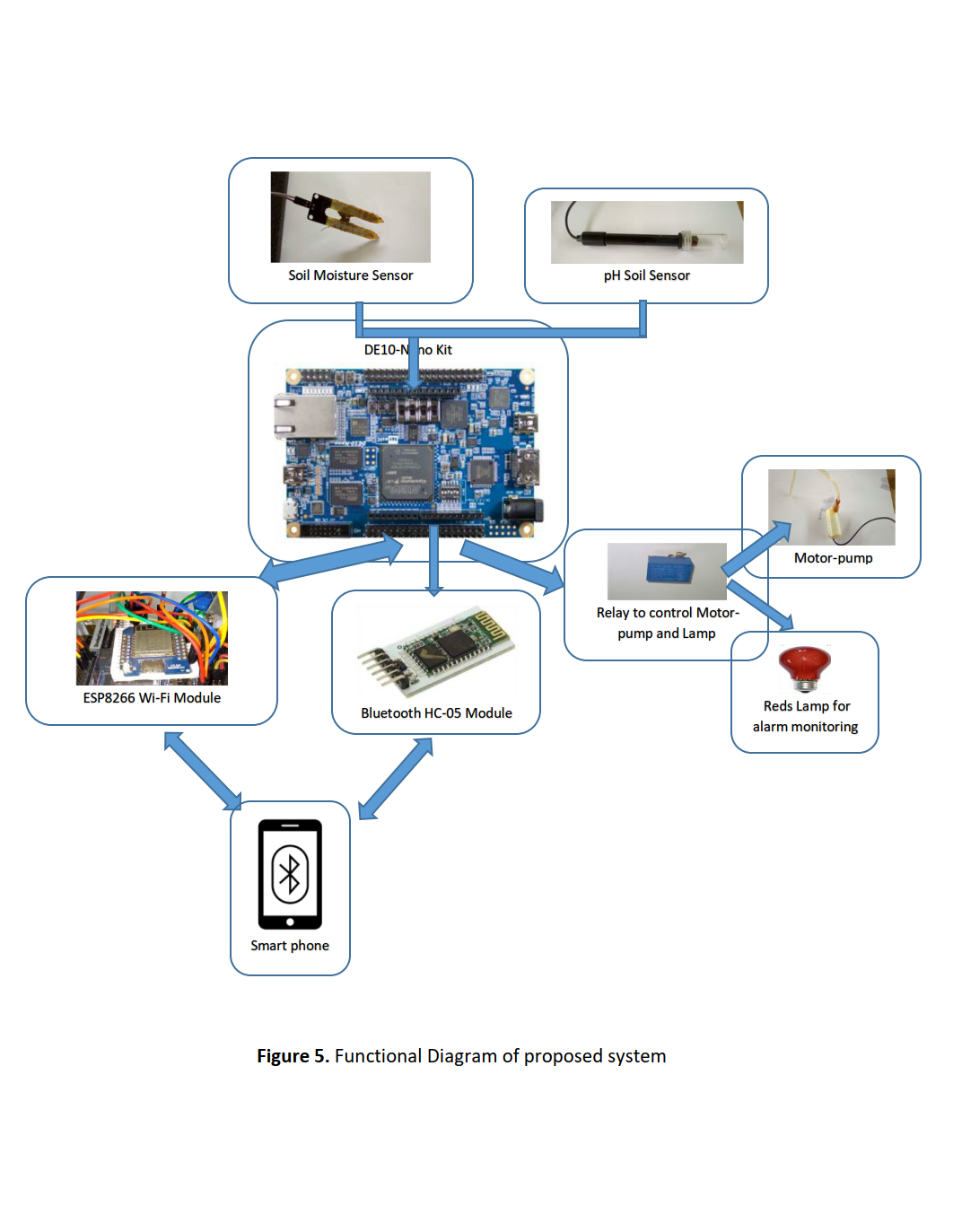
In this block diagram, the soil moisture and pH are delivered by the sensor. The various values delivered are acquired by 10-bits ADC available on the DE10-Nano kit. The FPGA can reach the ADC by ADC series controller thus giving access of the NIOS II instantiated with various elements in Platform Designer on Quartus II. Thus The software system implemented in Eclipse software making it possible the NIOS II to access to the resources. The implemented algorithms make it possible to recover the acquired values, to in addition send these values by Bluetooth and Wi-Fi through the HC-05 and ESP8266 module respectively. The Wi-Fi ESP8266 module is choosing because it is very practical to establish a Wi-Fi connection with the MQTT protocol. it connects oneself directly to an access point representing a single MQTT waiter called Broker. The recovery of the transmitted data is done while subscribing to a topic. In our system our broker is "broker.emqx.io" while the definite topics are: AgricP/PH_Val for the recovery of the pH and AgricP/SoilM for the recovery of the soil moisture. These topics are used in the Wi-Fi application developed to the smartphone for monitoring.
Continuously the values are sent in the Bluetooth and Wi-Fi applications developed in Smartphone starting from Bluetooth Electronics and IoTMQTTPanel respectively with a message giving the state of the soil compared to these parameters. The interfaces developed are shown in figure 6 and 7. The standardized values of the acquired parameters quoted in the literature are defined for the treatment. It is between 6,5 and 7,5 for better pH [2] and more than 50% for moisture. In the case of soil moisture, when the soil moisture is below 50%, the red LED shines and the motor-pump starts irrigating the soil. Even if the famer is not there, he is informed in real time and can thus take good decisions to optimize his production and to preserve the ecosystem and his biodiversity.
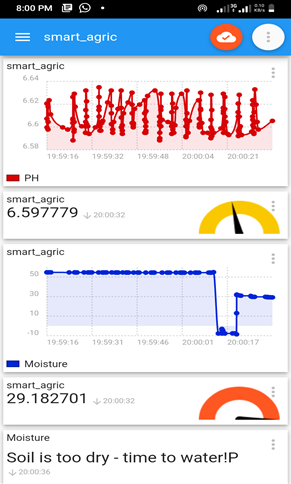
Fig.6. Wi-Fi Interface on smartphone
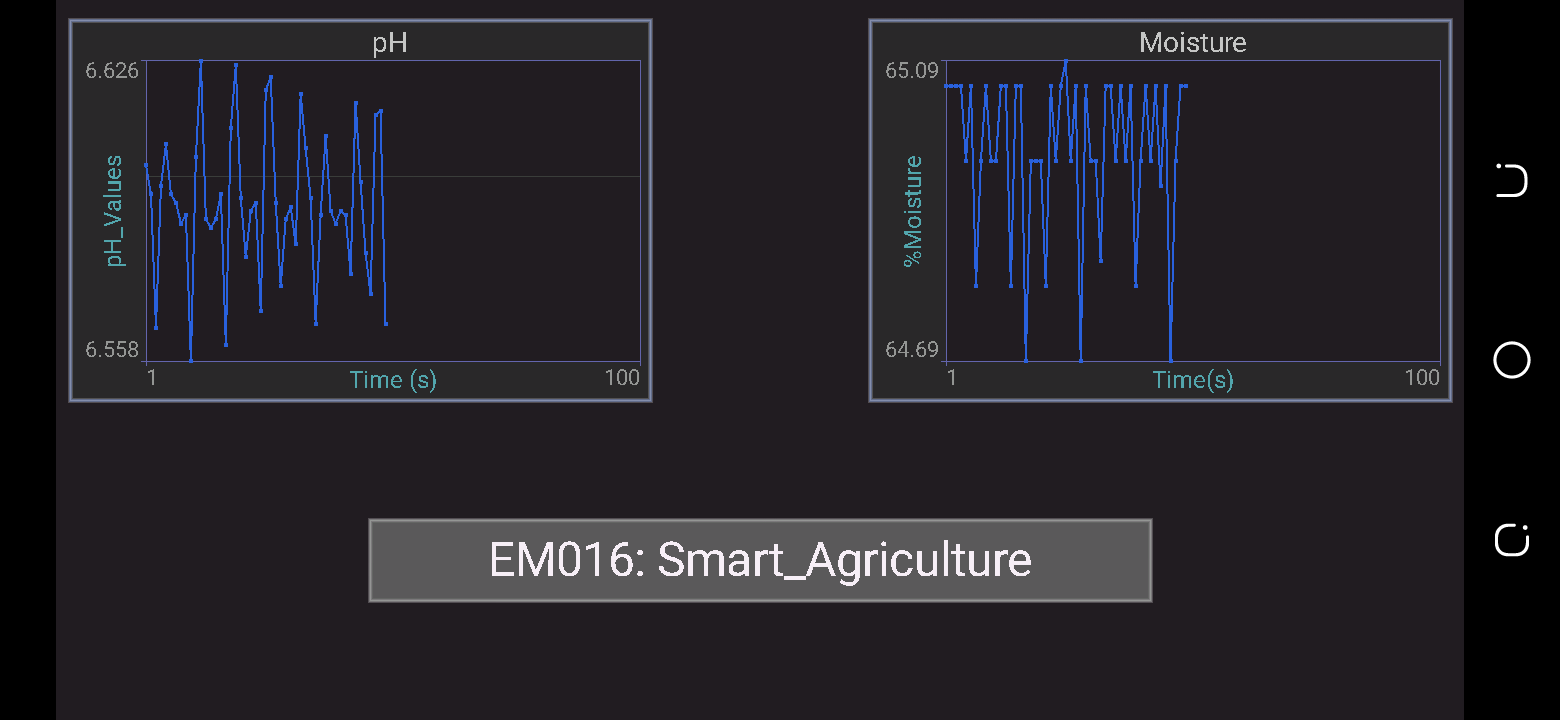
Fig. 7. Bluetooth Interface on smartphone
6. Performance metrics, performance to expectation
The proposed system is given on figure 8.
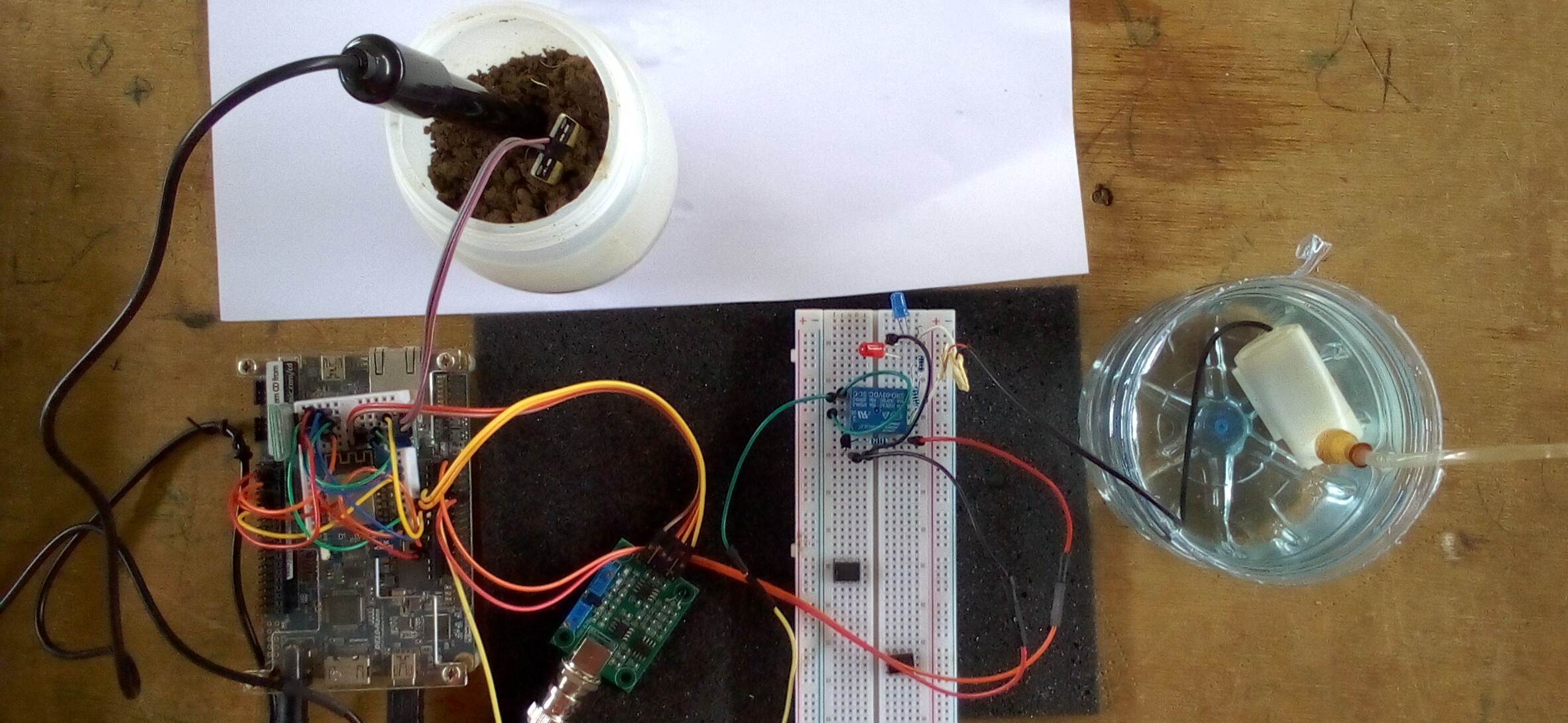
Fig. 8. Proposed system
It consists of 01 DE10 Nano FPGA, 01 Smartphone, 01 Wi-Fi ESP8266 module, 01 Bluetooth HC05 module, 01 soil moisture sensor, 01 soil pH sensor, 01 motor-pump for the system of irrigation, 01 electronic relays to control the motor-pump, 01 NPN bipolar transistor and 01 Led of indication of the irrigation.
Compared to the operation of our systems, the parameters of performance are:
- The acquisition of the values of the pH and the moisture of the ground with a rather significant precision;
- Transmission in real time of the values acquired by Bluetooth and Wi-Fi;
- Scope daily of the evolution of the soil parameters to make prevision on the agricultural farm and to preserve the biodiversity;
- Automatic and effective reaction of the system of irrigation when the soil moisture is less than 50% according to the standard.
Figures 9, 10 and 11 present acquisition in real times of the parameters. In addition to that the precision of the parameters given in figure 10 and 11 is rather significant since it is 10-6 near. On these same figures one can observe the daily evolution of the soil parameters with time indication. That makes it possible to envisage the evolution of the soil and to make decisions to preserve the biodiversity. One can in addition see in figure 10 and 11 that when the soil moisture is good, the blue LED is lit and the system of irrigation is not activated. On the other hand, when moisture is not good, the red LED ignites and the system of irrigation is activated. To the glance all these parameters validated, we can say that our system functions with satisfaction.
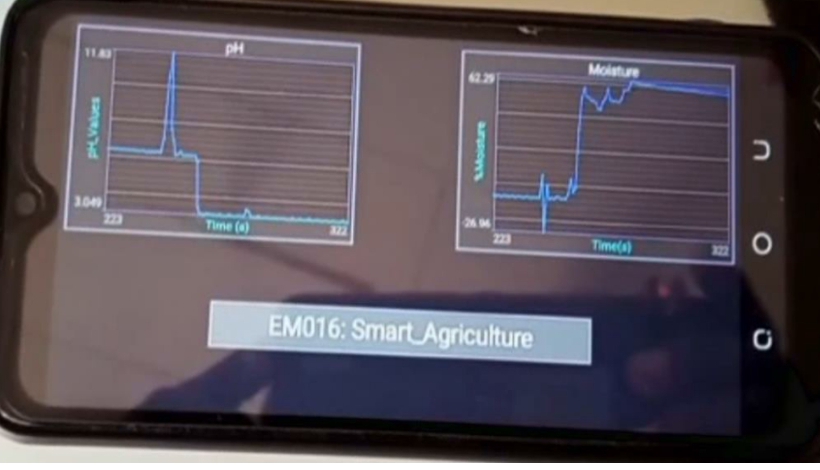
Fig. 9. Soil pH and moisture Acquisition on Bluetooth Interface
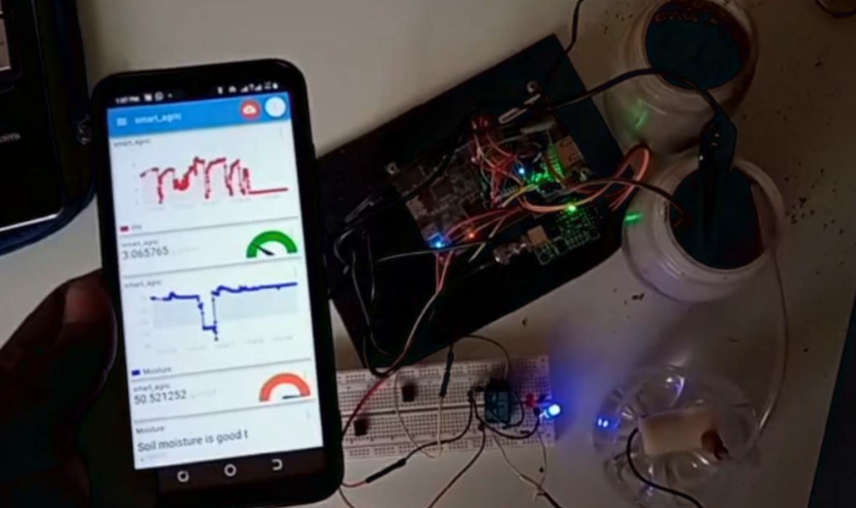
Fig. 10. Soil pH and moisture Acquisition on Wi-Fi Interface: good moisture
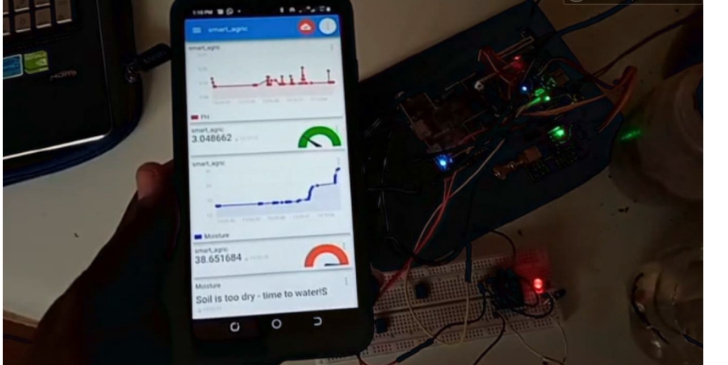
Fig. 11. Soil pH and moisture Acquisition on Wi-Fi Interface: bad moisture
Our system reacts thus because it has as a core a FPGA for the digital processing. Indeed, as one said, it is the parallel treatment with large frequency which allows this reaction and transmission in real time. Another processor would spend more time to react and that would cause errors of analysis and prevision.
7. Sustainability results, resource savings achieved
The NIOS II instantiated in Platform Designer is given on figure 12. It comprises:
- A NIOS II processor allowing to manage all the operations of the system ;
- Three ports UART for module ESP8266, the module Bluetooth HC05 and an extension for a module GSM;
- A Timers allowing to manage the intervals of time of the system;
- A ADC for acquisition
- A system ID allowing to give an identifier to our system;
- A Jtag Uart for the communication series by Jtag of the FPGA with the PC;
- A memory which must contain all the numerical program;
- Input/Output
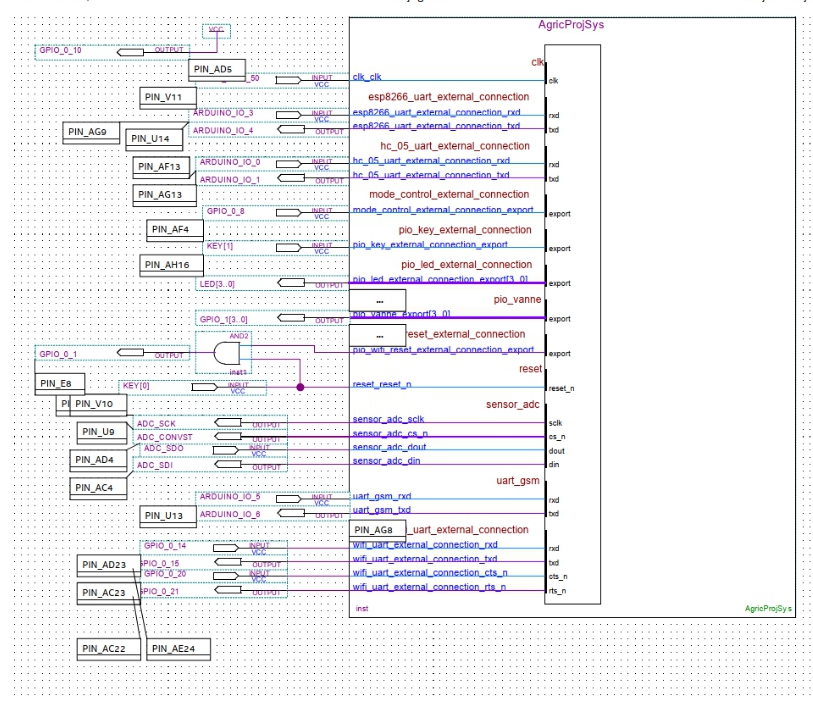
Fig.12. NIOS II Instantiated
Figure 13 presents the synthesis of the resources utilization in the FPGA. One can notice that the utilization ratios are very weak that shows that the Kit can still be used for a system very diversified in activity with more spots. It is here also one of the advantages of using the FPGA.
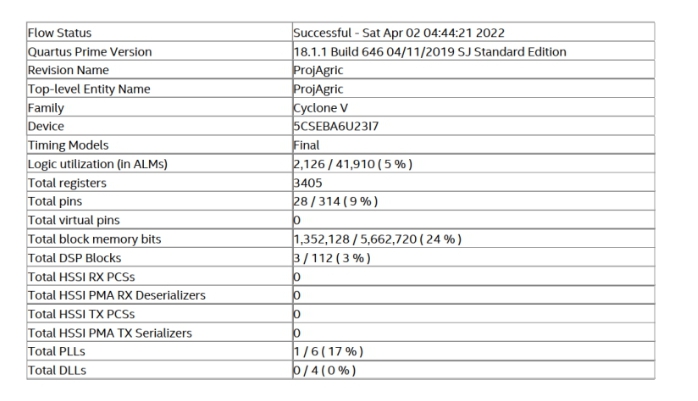
Fig.13. Hardware utilization synthesis
8. Conclusion
Ultimately, it was a question in our project of carrying out a system of preservation of the biodiversity through an intelligent agriculture connected to the cloud by FPGA. The goal was to control simultaneous and in real time, the soil parameters in order to better exploit it in an agriculture to also improve quality and the quantity of production all while preserving it of the destruction. Thus, it was necessary to control at the same time the soil pH, moisture, and NPK nutriments. All this remains feasible thanks to the use of a FPGA which has the advantage of parallel treatment of the data with great frequencies and by using less numerical resources. The constantly control passes by a data collection in anywhere at any time. Also, it is important to do it by preserving the world's resources for sustainable development. It is why the essential element, the soil, was selected for our project because the sustainable development passes by the control of the soil. The acquired parameters make it possible to avoid a bad exploitation of the soil because it causes an impoverishment of the soil. It is the solution that our project brought which connected an agricultural farm to the cloud by Wi-Fi with MQTT protocol for an acquisition in real time and any place. In addition, a Bluetooth module was added in order to increase flexibilities of the system. The results obtained were very satisfactory because the system gathers in real time the data and simultaneously transmits them by Bluetooth and Wi-Fi, it reacts promptly to the system of irrigation according to the state of the soil. Two interfaces of monitoring on smartphone were developed. The system suggested is thus ready to be to exploit within the framework of the sustainable development and the preservation of the biodiversity.
References:
- C. S. A. Ballot, G. MAwUSSI, w. Atakpama, M. moita-nassy, T. M. yangakola, I. Zinga, Silla S, Kpérkouma w, G. Dercon, Komlan B et Koffi A, 2016. ‘‘Caractérisation physico-chimique des sols en vue de l’amélioration de la productivité du manioc (manihot esculenta Crantz) dans la région de damara au centre-sud de centrafrique’’. Agronomie Africaine, vol 28 (1), pp 9 – 23.
- Chambre d’agriculture de la Drôme, novembre 2013. ‘’ Analyser son sol pour mieux le connaître’’. N°64.
- Ramya Venkatesan and Anandhi Tamilvanan, April 6-8, 2017. ‘‘A Sustainable Agricultural System Using IoT.’’ International Conference on Communication and Signal Processing India. pp 0763-0767.
- D.Murali, Rama Krishna Tummala, Sanjeev Kumar A.N, Dr.E.Bhuvaneswari, Dr.R.Venkatesan, 2021. “SUSTAINABLE FARMING FOR AGRICULTURE IMPROVEMENT USING IOT”. International Journal of Modern Agriculture, Volume 10, No.1, 2021
ISSN: 2305-7246. pp:106-115
1 Comments
Please login to post a comment.
Ferdinand Kisito Jules SEME
I think this project can be used in all regions of Cameroon and for all crops.
Very good work, I would like to read the rest of your work.
Best regards....